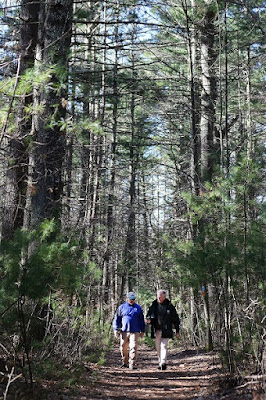On one of the coldest days of the year, Wenley
Ferguson fights the wind at the edge of Quonochontaug Pond in Charlestown.
Bundled in a parka and knee-high rubber boots, she watches as workers use two
large hydraulic dredges to pump a slurry of sand and water a quarter mile
through an orange flexible pipe and onto the adjacent salt marsh in an effort
to raise the elevation of the wetland. With flocks of gulls and shorebirds called
dunlin gathering at the outflow pipe to forage for tiny marine creatures, two
bulldozer drivers push the sandy sediments around on top of the delicate marsh,
grading the site to create areas of high- and low-marsh habitat, as well as
drainage channels so water does not pool on the surface as the tide recedes.
The habitat restoration coordinator for Save the
Bay, Ferguson and Caitlin Chaffee from the Rhode Island Coastal Resources
Management Council oversee the team of workers as they
endure the challenging
conditions to complete the first stage of what officials hope will save the
marsh from rising seas.
 |
| Roy Carpenter's Beach after Super Storm Sandy (Michael Cevoli) |
“It looks a bit like a desert at the moment,”
admits Ferguson, who calls the effort a sediment placement project. In a year
or two, however, after native marsh plants have been planted and nature has had
a chance to carve its signature into the project, the marsh will look and work
like it did before sea level began its rapid ascent.
“We’re taking these extreme measures to place
sediment on degraded salt marshes because we’ve seen widespread loss of salt
marsh vegetation over the last 15 years,” says Ferguson. “A healthy marsh can
build elevation through its root matter or through the accretion of sediments,
but our marshes aren’t keeping pace with sea level rise.
During the last 20 years, sea level has risen an
average of 5 millimeters per year, but local salt marshes are building
elevation at just 2 millimeters per year. “And millimeters matter,” Ferguson
notes. While salt marsh vegetation thrives on the twice daily influx of water
from the tides, the rising sea level has meant that many of the Ocean State’s
salt marshes are becoming permanently flooded, killing the vegetation where
rare birds nest, and negating the marsh’s ability to cushion surging storms.
The Quonochontaug project follows similar efforts
at Sachuest Point National Wildlife Refuge in Middletown, the Narrow River in
Narragansett, and Ninigret Pond in Charlestown.
A decade ago it would have been
unthinkable for Ferguson to stand idly by as dredged material was dumped on a salt
marsh. She spent much of the 1990s and 2000s removing fill and other
impediments to the natural tidal flow at more than a dozen marshes damaged by
human disturbances in the state. Under
normal circumstances, Ferguson may have been one of the first to stand in the
way of a heavy bulldozer driving over the fragile marsh plants. But the
circumstances these days are anything but normal.
According to a gauge in Narragansett
Bay, sea level has risen 11 inches since 1930, most of it in the last three
decades. The
National Oceanic and Atmospheric Administration recently raised its estimates
for future sea level rise to five feet by 2050 and more than 11 feet by 2100.
During moon tides and major storms, water levels will get even higher. And that
means that most of Rhode Island’s salt marshes – and much of the rest of the
coastline – will soon become flooded. The changing climate is driving other
dramatic changes in the Ocean State as well, from increasingly damaging storm
runoff to degraded forests and heat-related illnesses.
The state of Rhode Island
and its coastal communities, along with coastal businesses, residents and some
inland towns, are beginning to plan for the inevitable implications of climate
change. Structures are being raised, barriers are being built, and numerous
other strategies are being deployed in anticipation of....
Read the rest of this story in the June 2019 issue of Rhode Island Monthly magazine.





